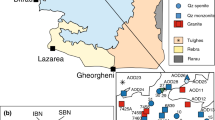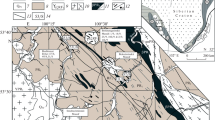Summary
The eastern part of the agpaitic Khibina complex is characterized by the occurrence of dykes of various alkali silicate rocks and carbonatites. Of these, picrite, monchiquite, nephelinite and phonolite have been studied here. Whole rock and mineral geochemical data indicate that monchiquites evolved from a picritic primary magma by olivine+ magnetite fractionation and subsequent steps involving magma mixing at crustal levels. None of these processes or assimilation/magma mixing of wall rocks or other plutonic rocks within the complex can entirely explain the geochemical and Nd–Sr-isotopic characteristics of the monchiquites (i.e. a covariant alignment between (87Sr/86Sr)370=0.70367, (143Nd/144Nd)370=0.51237 and (87Sr/86Sr)370=0.70400, (143Nd/144Nd)370=0.51225 representing the end points of the array). This signature points to isotopic heterogeneities of the mantle source of the dyke-producing magma. The four mantle components (i.e. depleted mantle, lower mantle plume component, EMI-like component and EMII-like component) must occur in different proportions on a small scale in order to explain the isotopic variations of the dyke rocks. The EMII-like component might be incorporated into the source area of the primary magma by carbonatitic fluids involving subducted crustal material. The most likely model to explain the small-scale isotopic heterogeneity is plume activity. The results of this study do not provide any support to a cogenetic origin (e.g. fractionation or liquid immiscibility) for carbonatite and monchiquite or other alkali-silicate dyke rocks occurring in spatial proximity. Instead, we propose that both, carbonatite and picrite/monchiquite, originated by low-degree partial melting of peridotite. Textural observations, mineralogical data, and C and O isotopic compositions suggest incorporation of calcite from carbonatite in monchiquite and the occurrence of late-stage carbothermal fluids.
Similar content being viewed by others
Author information
Authors and Affiliations
Electronic supplementary material
Rights and permissions
About this article
Cite this article
Sindern, S., Zaitsev, A., Demény, A. et al. Mineralogy and geochemistry of silicate dyke rocks associated with carbonatites from the Khibina complex (Kola, Russia) – isotope constraints on genesis and small-scale mantle sources. Mineralogy and Petrology 80, 215–239 (2004). https://doi.org/10.1007/s00710-003-0016-2
Received:
Accepted:
Issue Date:
DOI: https://doi.org/10.1007/s00710-003-0016-2




